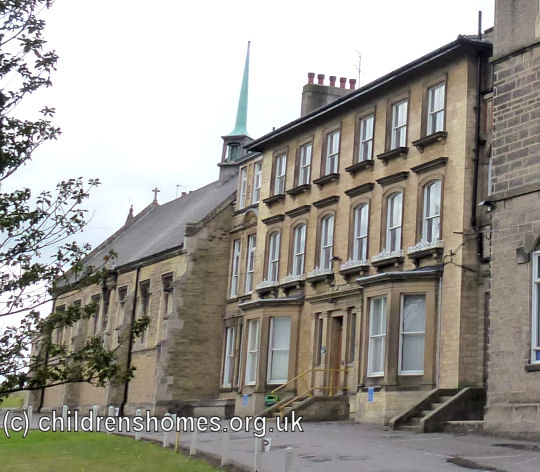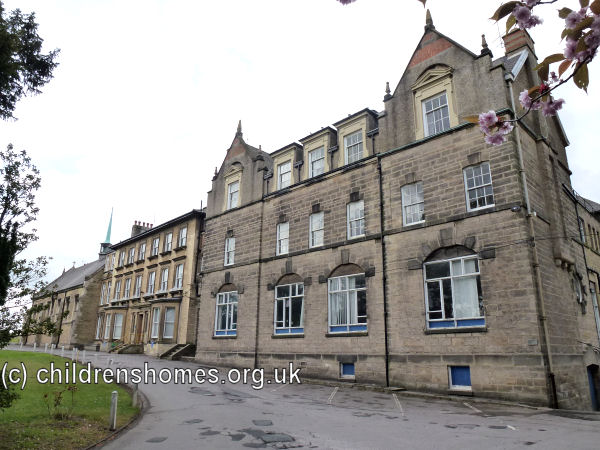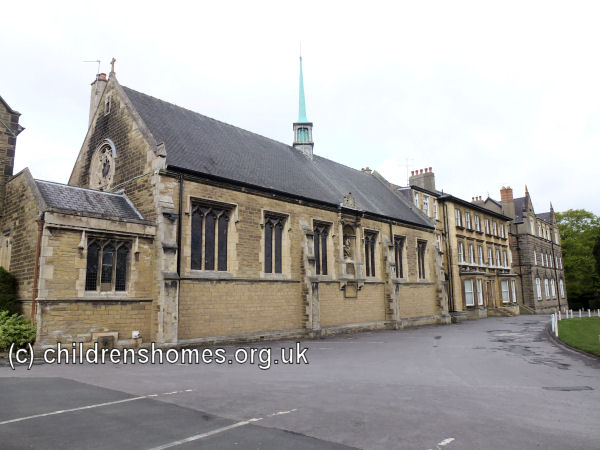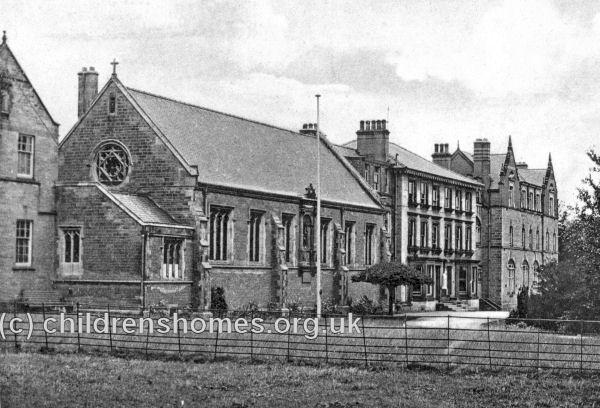St John's Institution for the Deaf and Dumb, West Riding of Yorkshire
The St John's Institution (or Institute) for Deaf and Dumb Catholic children was founded in 1870 by a Belgian priest, Canon (later Bishop) Désiré de Haerne. The Institution's first premises, opened on 9th June 1870, were at Handsworth Woodhouse, in the eastern outskirts of Sheffield. The establishment was dedicated to St John of Beverley and run by nuns from the Daughters of Charity of St Vincent de Paul
In 1875, Institution moved to new, purpose-built premises at Church Lane, Boston Spa.

St John's Catholic School for the Deaf - chapel and entrance block, Boston Spa, 2013. © Peter Higginbotham
In May, 1880, the Bishop of Leeds laid the corner stone of a new wing which would eventually accommodate 100 girls. It included a refectory, classroom, workrooms and a dormitory. An underground tank for soft water, capable of containing 40,000 gallons, was also provided. The total accommodation at the establishment eventually reached 208 places.

St John's Catholic School for the Deaf - 1880s extension block, Boston Spa, 2013. © Peter Higginbotham
Applicants had to be at least 7 years of age, of sound mind and capable of instruction, not liable to fits, and have been vaccinated or had smallpox. Children were received from all parts of England, Wales, and Scotland. Non-Catholics were admitted only with the written consent of parents or guardians. A payment of £20 per annum was required for each inmate, payable quarterly in advance, although a reduction was made in exceptional cases. The sum of £3 was also required for outfit on entrance, with clothing subsequently being provided.
On April 22nd, 1886, the Institution was accredited as a Certified School, allowing it to receive children boarded out by the workhouse authorities. Those placed by Boards of Guardians were charged for at the rate of £15 per annum, plus an initial £3 for an outfit. The certificate continued in operation until 13th January, 1920.
Teaching at St John's was by the 'oral system'. In addition to classroom instruction, the boys were taught trades and the girls household work, laundry work, and needlework. Inmates typically remained for about six years. The Institution also took 'parlour boarders' — children from better-off families who enjoyed extra facilities, principally their own sitting-room or parlour.
A new chapel, designed by Charles Hadfield, was opened on 30th, October 1889.

St John's Catholic School for the Deaf - chapel, Boston Spa, 2013. © Peter Higginbotham

St John's Catholic School for the Deaf - chapel, Boston Spa, early 1900s. © Peter Higginbotham
In 1902, a pair of houses was rented at 39-41 Henry Street, Redcar, as a holiday and convalescent home for the children. One house accommodated the boys, and the other the girls. The property, known as St John's Lodge, was subsequently purchased by the school in 1914 for the sum of £980.
39-41 Henry Street, Redcar
By 1920, the industrial training provided at the Institution included dairy work, needlework, knitting, lace-making, dress-making, crochet work, carpentry, shoemaking, tailoring, farm and garden work, printing and bookbinding.
At the outbreak of the Second World War in 1939, one wing of the St John's building was used to accommodate girls evacuated from the St Margaret's Home in Leeds. After the girls moved to new premises in Leeds in November, 1940, they were replaced by boys from the St Vincent's Boys' Home in Leeds who remained until the end of the war.
After the war, the Institution began to drop the phrase "and Dumb" from its name, and is now known as St John's Catholic School for the Deaf. Because of the length of the name, it is usually rendered in sign language simply as 'Boston Spa'.
In the 1970s, the former St Joseph's Home at 27 Church was taken over by St John's as an annexe for children who could not cope well in the main school. It was known as the St Vincent's Unit.
In 2008, seven former male pupils at St John's won compensation claims against the Leeds Diocese as a result of their sexual abuse by at Father Neil Gallanagh, who became resident chaplain at the School in 1974, despite having a previous conviction for a similar offence of which the Diocese was aware.
The Daughters of Charity continued to work at St John's until 1998.
St John's still continues its work as a day and boarding school for hearing impaired pupils aged from 3 to 19.
Records
Note: many repositories impose a closure period of up to 100 years for records identifying individuals. Before travelling a long distance, always check that the records you want to consult will be available.
- Catholic Care (Diocese of Leeds), 11 North Grange Road Headingley, Leeds LS6 2BR.
- Leeds Roman Catholic Diocesan Archives, Hinsley Hall, 62 Headingley Lane, Leeds LS6 2BX. Has Leeds Diocesan Rescue and Protection Society Annual Reports (1912 onwards).
Census
Bibliography
- Taylor, Joselyn Boston Spa: the story of St. John's Catholic School for Deaf Children, 1875–1975 (2007, British Deaf History Society)
- Finnigan, Robert et al, 150th Anniversary History 1863-2013 Catholic Care, Diocese of Leeds (2013, Catholic Care)
Links
- St John's School website
- Daughters of Charity (British Province)
- Daughters of Charity of St Vincent de Paul Services
Except where indicated, this page () © Peter Higginbotham. Contents may not be reproduced without permission.


